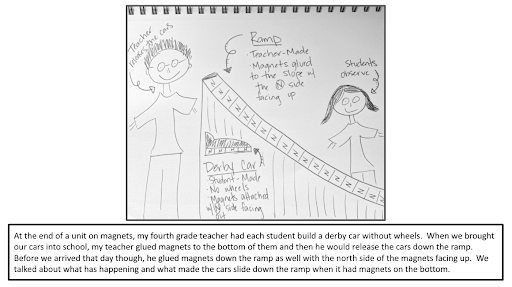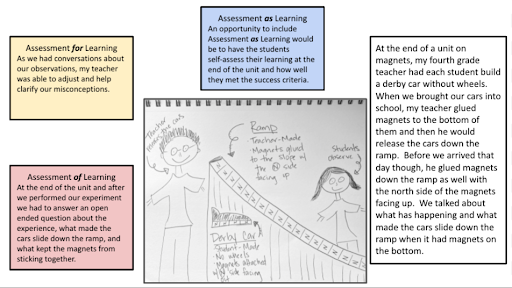Summary
During this second day of the Formative Assessment Institute, participants focus on distinguishing assessment of learning, assessment for learning, and assessment as learning.
Essential Question
What is the role of assessment in the design of effective learning environments?
Materials List
Presentation Slides (attached)
Note Catcher (attached; one per participant)
Formative Assessment for the Classroom Teacher (attached; one per participant)
Concept Card Mapping (attached; one per group)
Paper
Chart paper (one sheet per small group)
Markers, crayons, colored pencils, etc.
Sticky notes (a few notes per participant)
Highlighters
Pens or pencils
Laptops or other personal device (one per participant)
Wifi
Learning Goals
Define formative assessment.
Determine the purposes of formative assessment in the classroom.
Explain the difference between assessment of learning, assessment for learning, and assessment as learning.
Engage
Welcome participants and briefly introduce yourself. Using the attached Presentation Slides, display slide 2 and welcome your participants to the Formative Assessment Institute.
Display slide 3. Share with your participants that this is just day two of a four-day professional development institute covering formative assessment in the classroom.
Slides 4-6 are the GEAR UP for the FUTURE, O+K=C, and MY SUCCESS goals. Share the appropriate grant goals with your participants and hide the other two slides.
Display slide 7 and share the essential question for the institute: What is the role of assessment in the design of effective learning environments?
Display slide 8 and share the session objectives with your participants:
Define formative assessment.
Determine the purposes of formative assessment in the classroom.
Explain the difference between assessment of learning, assessment for learning, and assessment as learning.
Display slide 9 and remind your participants of the definition they wrote together of assessment by saying, “Yesterday we created a group definition of assessment that includes summative, diagnostic, and formative assessment. Let’s take a look at that definition again.”
Display slide 10 and share the instructional strategy How Am I Feeling? What Am I Thinking? Tell your participants that you want to gauge how they are feeling and thinking based on the first day of the institute. Just like it’s important to check in on their students, it’s important for you to check in on them.
Explore
Display slide 11 and share the instructional strategy Cognitive Comics with your participants. Say, ”Our first activity today is to get you thinking about classroom learning environments by asking you to think of a learning experience you had in the past that was memorable and/or helped enrich your learning. We will revisit this later in today’s session.” Have participants close their eyes and think back to a memorable classroom learning experience from their childhood that stuck with them.
Move to slide 12, and share an example with participants of what they will be creating.

Display slide 13, and remind your participants that they should be drawing a picture of their learning experience, providing key details of the learning experience, and including a caption that describes what occurred. Share with your participants that they will be returning to this later on in the session so including as much detail as possible now is important.
Explain
Display slide 14 and say, ”We have created a definition of assessment that identifies three main types of assessment but there are other ways to think about the purposes of assessment. One way that many people use is to think about how three simple prepositions can change the meaning of how we approach assessment in different situations. Different types of assessment have certain things in common: gathering evidence, interpreting that evidence, and using the interpretation in some way. But how each of these things is carried out is determined by the purpose of the assessment.”
Display slide 15. Read the three short descriptions of each of these ideas, and discuss how the preposition describes a different purpose for learning in each one. See the following examples for each:
A teacher gives her students a comprehensive final at the end of a unit on biodiversity. What makes “of” appropriate here? What type of assessment might this be (summative, diagnostic, or formative)?
A teacher asks his students to do an Exit Ticket describing the three things they learned and two things they still need to know more about. What makes “for” appropriate here? What type of assessment might this be (summative, diagnostic, or formative)?
A teacher asks students to peer edit paragraphs written by others and then discuss their edits. What makes “as” appropriate here? What type of assessment might this be (summative, diagnostic, or formative)?
Display slide 16 and share the following video, “Formative Assessment,” which summarizes what participants have looked at so far.
Display slide 17 and share the instructional strategy I Think, We Think with your participants. As the scenarios are shared, instruct your participants to think about whether it is describing assessment as learning, assessment for learning, or assessment of learning.
Begin by moving to slide 18.
Display slide 23 and instruct your participants to retrieve their cognitive comics from earlier. Say, “We are now going to go back to your cognitive comics and have you label instances where assessment of, as, and/or for learning are occurring. Think about whether or not learner-centered, knowledge-centered, assessment-centered, and community-centered environments were integrated into that learning experience and discuss why this is important.”
Assessment as Learning: Blue
Assessment of Learning: Pink
Assessment for Learning: Yellow
Display slide 24 and share the example from earlier with the added assessment types labeled.

Display slide 25 which includes the example and the instructions together.
Display slide 26 and ask participants, “let’s go back to our Anchor Chart and look for patterns. In thinking about the purposes for formative assessment, what stands out as a big idea or two about what formative assessment is used for?”
Display slide 27, pass out the attached reading, The Purposes of Formative Assessment, and say, ”Here are some ideas from Page Keeley in her book about purposes for which formative assessment can be used in the classroom. After the break, you will do a variation on a card sort to see how you might match up these purposes with different kinds of strategies from the LEARN site.”
Display slide 28, pass out the attached Note Catcher, and provide participants time to reflect on the assessment strategies that they have participated in up to this point. Have participants answer the question, ”How was (the strategy) used and how can I use it?”
Once they finish this activity, give your participants a break.
Extend
Display slide 29. Share the instructional strategy Concept Card Mapping with your participants. Make sure each small group has a copy of the attached Concept Card Mapping Cards. Instruct them to spread their cards out on their chart paper and read through each card. As a group, they should discuss which of the strategies relate to which of the purposes of formative assessment, keeping in mind that multiple strategies will fit for multiple purposes and vice versa. Once they have organized their cards, have them glue them in place and show the multiple relationships by connecting them with lines.
Display slide 30. Once all of your participants have completed their maps, share the instructional strategy Gallery Walk. Instruct your participants to walk around the room and look at each other’s concept maps. If participants have questions, they should write each question on a sticky note and leave it on the chart paper.
Display slide 31 once your participants have finished their Gallery Walk. Hold a group discussion about what they noticed—similarities and differences—and provide them an opportunity to answer any questions that were left on their chart paper. The purpose of this is for participants to walk away with the idea that this learning is not about the strategies themselves, but more about the purpose and intent behind using them. What do participants expect to see or get by using the strategy?
Evaluate
Display slide 32 and share the instructional strategy Six-Word Memoir with your participants. Have your participants summarize their learning in six words or less that best reflect the purposes of formative assessment. Distribute your premade Mentimeter link, and have participants share their memoirs via Mentimeter on any device.
Display slide 33 and bring your participants’ attention back to their Note Catchers. Provide them time to reflect on the assessment strategies that they have participated in up to this point. On their Note Catchers, they should answer the question, ”How was it used and how can I use it?”
Before your participants leave for the day, instruct them to bring in samples of student work for the next session.
Follow-Up Activities
Research Rationale
Analyzing the current skill level of students in a classroom at any given time and determining the best course of action to ensure they all meet the target learning goals can be a challenge, even for seasoned teachers. The idea of using formative assessment to meet students' individual needs is not new. In fact, researchers as far back as Benjamin Bloom have shown that one-to-one tutoring is the most effective form of instruction because of the tutor’s ability to pinpoint misconceptions and provide immediate feedback and correctives (William, 2011). Despite continued research that shows formative assessment can enhance student success, many teachers struggle to use the full array of formative assessment practices available. The question then becomes: What can teachers do to effectively improve and enhance their use of formative assessment in the classroom environment?
Resources
K20 Center. (n.d.). Cognitive comics. Strategies. https://learn.k20center.ou.edu/strategy/198
K20 Center. (n.d.). Concept card mapping. Strategies. https://learn.k20center.ou.edu/strategy/123
K20 Center. (July 2021). Formative assessment. YouTube. https://youtu.be/OxPcSne3pEg
K20 Center. (n.d.). Gallery walk / carousel. Strategies. https://learn.k20center.ou.edu/strategy/118
K20 Center. (n.d.). How am I feeling? What am I thinking?. Strategies. https://learn.k20center.ou.edu/strategy/187
K20 Center. (n.d.). I think / we think. Strategies. https://learn.k20center.ou.edu/strategy/141
K20 Center. (n.d.). Mentimeter. Tech tools. https://learn.k20center.ou.edu/tech-tool/645
K20 Center. (n.d.). Six-word memoirs. Strategies. https://learn.k20center.ou.edu/strategy/75
Keeley, P. (2016). Science formative assessment: 75 practical strategies for linking assessment, instruction, and learning (Vol. 1). Thousand Oaks, CA: Corwin.
Wiliam, D. (2011). What is assessment for learning? Studies in Educational Evaluation, 37(1), 3-14. doi:https://doi.org/10.1016/j.stueduc.2011.03.001



